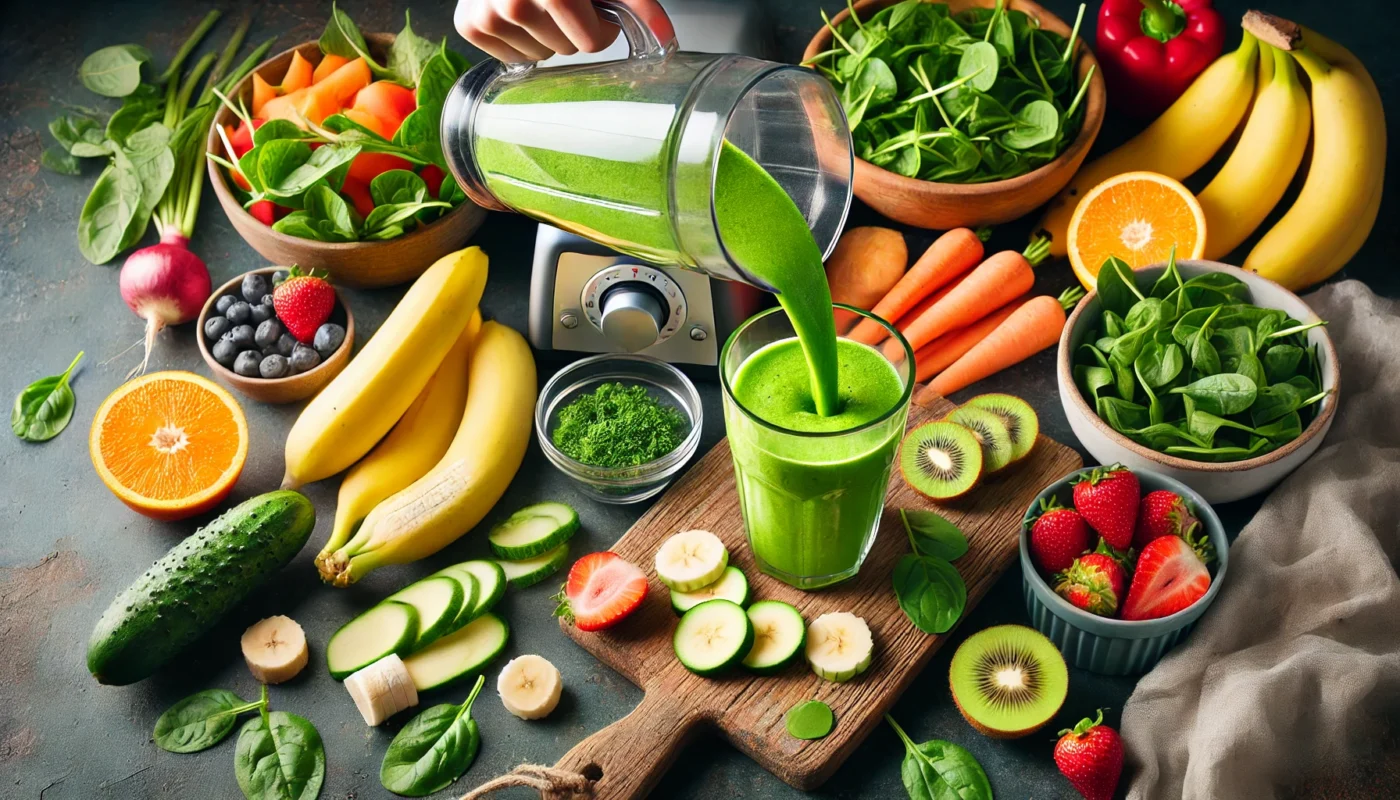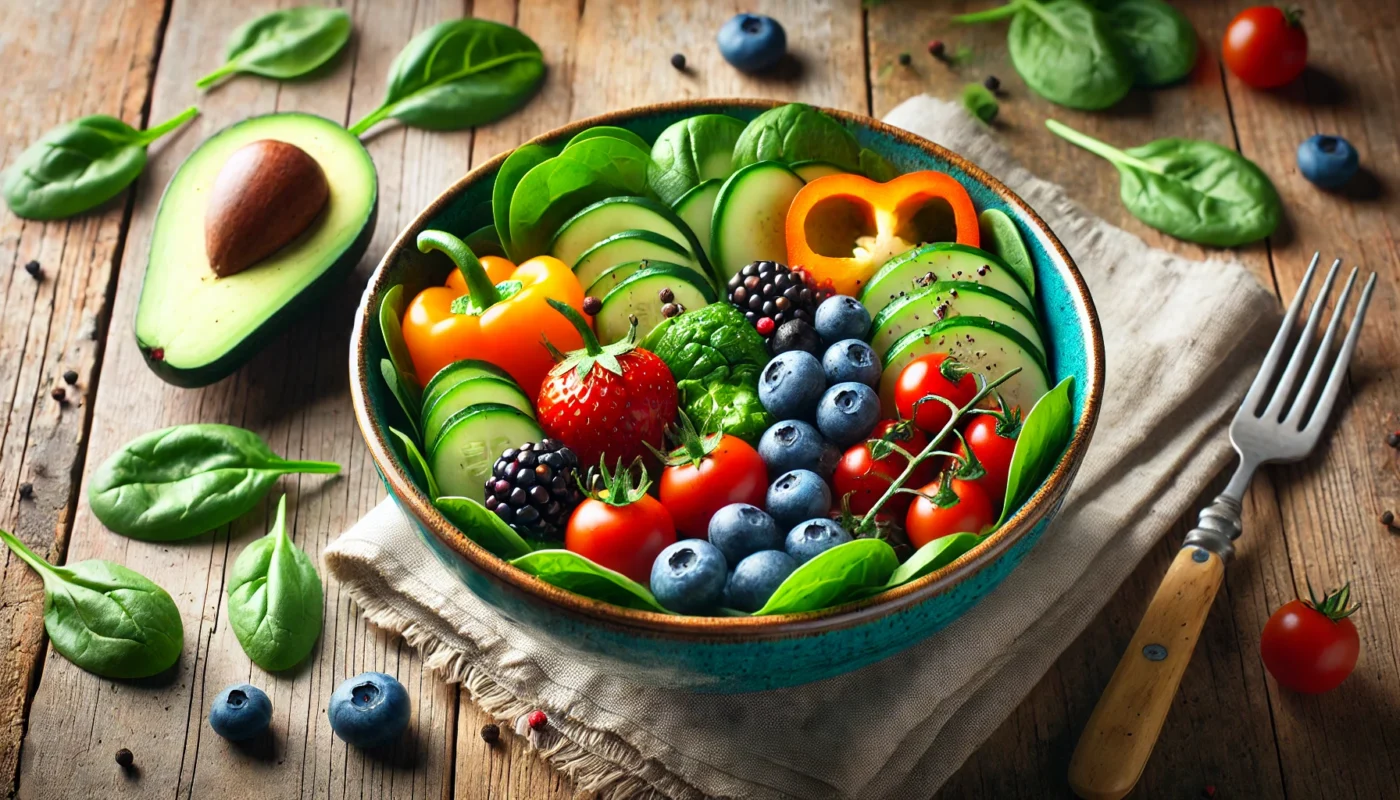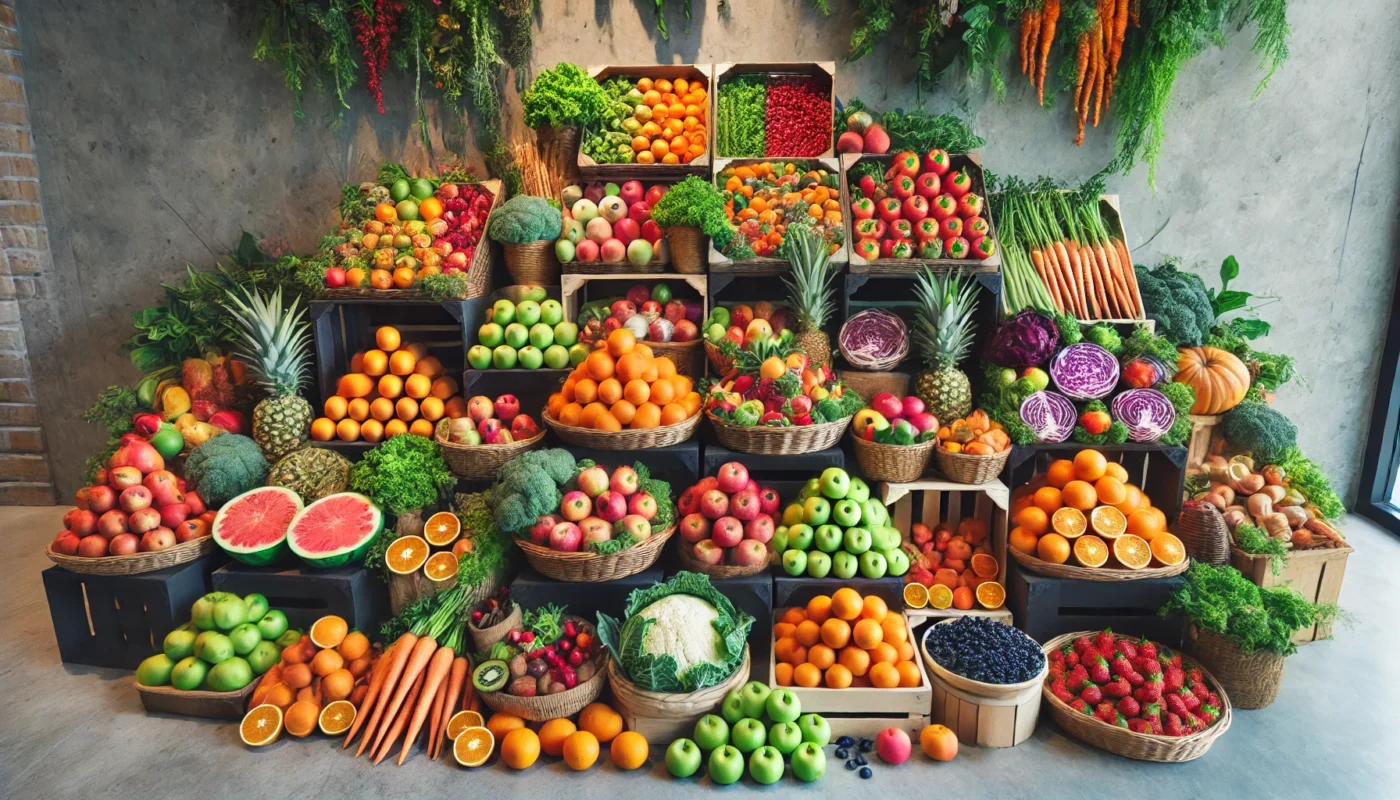The Importance of Fruits and Vegetables in a Healthy Diet
Eating a diet rich in fruits and vegetables is one of the most effective ways to improve overall health and well-being. These natural, nutrient-dense foods provide essential vitamins, minerals, fiber, and antioxidants that support various bodily functions and protect against chronic diseases. Incorporating more fruits and vegetables into your daily meals can significantly impact your physical health, mental well-being, and long-term vitality. However, many individuals struggle with consuming the recommended daily intake due to various barriers such as taste preferences, convenience, and lack of knowledge about preparation methods. Understanding the benefits of these nutrient-rich foods and exploring practical strategies to incorporate them into daily meals can transform eating habits and promote long-term wellness.
You may also like: How to Start a Whole Food Plant-Based Diet: A Beginner’s Guide to Healthier Eating
Understanding the Health Benefits of Fruits and Vegetables
The health benefits of fruits and vegetables extend far beyond simple nutrition. These foods are packed with fiber, which aids digestion and promotes gut health. The diverse range of vitamins and minerals found in fruits and vegetables supports immune function, cardiovascular health, and cognitive performance. Antioxidants present in colorful produce help combat oxidative stress, reducing inflammation and lowering the risk of chronic diseases such as heart disease, diabetes, and cancer. Additionally, fruits and vegetables contribute to weight management by providing low-calorie, high-nutrient options that promote satiety and prevent overeating. The variety of flavors, textures, and nutrients available in different fruits and vegetables allows individuals to create diverse and satisfying meals while maintaining optimal health.
Overcoming Barriers to Eating More Fruits and Vegetables
Despite the well-documented benefits of eating fruits and vegetables, many individuals face obstacles that prevent them from meeting their recommended intake. One common challenge is the perception that fresh produce is expensive or difficult to prepare. However, with strategic planning and budgeting, it is possible to incorporate more fruits and vegetables into meals without exceeding a grocery budget. Another barrier is taste preference, as some individuals may not enjoy certain vegetables in their raw form. Cooking techniques such as roasting, grilling, and blending can enhance the flavor and texture of vegetables, making them more appealing. Additionally, lack of knowledge about which fruits and vegetables are the healthiest or how to store them properly can lead to food waste and decreased consumption. Educating oneself on the best storage methods and diverse preparation techniques can help overcome these challenges and encourage a more plant-based approach to eating.

Creative Ways to Incorporate More Fruits and Vegetables into Meals
Finding innovative ways to include more fruits and vegetables in meals can make the transition to a plant-focused diet enjoyable and sustainable. Smoothies are an excellent way to pack multiple servings of fruits and vegetables into a single meal, offering a convenient and delicious way to boost nutrient intake. Adding leafy greens such as spinach or kale to fruit-based smoothies enhances their nutritional value without significantly altering the taste. Another approach is to incorporate vegetables into familiar dishes, such as blending cauliflower into mashed potatoes or adding shredded carrots to pasta sauce. Experimenting with different cuisines and flavors, such as incorporating tropical fruits into salads or making vegetable-based dips like hummus, can also add variety and excitement to meals. The key is to make small, consistent changes that gradually increase the consumption of fruits and vegetables over time.
Choosing the Healthiest Fruits and Vegetables for Optimal Nutrition
Not all fruits and vegetables offer the same nutritional benefits, making it important to choose the healthiest options available. Dark leafy greens, such as spinach, kale, and Swiss chard, are rich in vitamins A, C, and K, as well as essential minerals like iron and calcium. Berries, including blueberries, strawberries, and raspberries, are packed with antioxidants that help protect against cellular damage and inflammation. Cruciferous vegetables like broccoli, Brussels sprouts, and cabbage provide powerful compounds that support detoxification and reduce the risk of chronic diseases. Citrus fruits, such as oranges, lemons, and grapefruits, offer a high dose of vitamin C, which is essential for immune function and skin health. By prioritizing nutrient-dense fruits and vegetables, individuals can maximize the health benefits of their diet while enjoying a variety of flavors and textures.
Practical Tips for Eating More Fruits and Vegetables Every Day
Adopting simple habits can make it easier to consume more fruits and vegetables daily. Keeping fresh produce readily available and visible encourages spontaneous snacking and meal preparation. Pre-washing and cutting fruits and vegetables ahead of time can also make them more convenient to grab on busy days. Incorporating vegetables into breakfast, such as adding bell peppers to omelets or topping oatmeal with fresh berries, can increase daily intake without significant effort. Making vegetables the main focus of meals, such as by preparing hearty salads, vegetable stir-fries, or plant-based soups, ensures a nutrient-rich diet. Setting goals, such as trying a new vegetable each week or aiming for a colorful plate at every meal, can also make the process more engaging and sustainable.
The Long-Term Impact of a Fruit and Vegetable-Rich Diet
Emphasizing fruits and vegetables in a daily diet has long-term benefits that extend beyond immediate health improvements. Consistently consuming a plant-rich diet reduces the risk of developing chronic diseases and supports longevity. Improved digestion, enhanced energy levels, and better mental clarity are common benefits of prioritizing plant-based nutrition. Additionally, adopting a diet centered around fruits and vegetables contributes to environmental sustainability by reducing reliance on processed and animal-based foods. By making conscious choices to increase fruit and vegetable consumption, individuals can experience lasting health improvements while supporting the well-being of future generations.

Frequently Asked Questions (FAQ) About Eating More Fruits and Vegetables
1. Why is it important to eat a wide variety of fruits and vegetables?
Eating a diverse range of healthy fruits and veggies ensures that you receive a broad spectrum of essential nutrients, including vitamins, minerals, and antioxidants. Different fruits and vegetables contain unique phytonutrients that support various aspects of health, from boosting immunity to reducing inflammation. For example, deep green vegetables like kale and spinach are rich in iron and folate, while brightly colored fruits like oranges and berries provide high levels of vitamin C and flavonoids. By consuming a variety of produce, you can improve gut health, enhance nutrient absorption, and reduce the risk of chronic diseases. A well-balanced fruit and veggie diet offers long-term benefits that go beyond basic nutrition, promoting overall vitality and longevity.
2. How can I make eating fruit and vegetables more enjoyable?
Many people struggle with incorporating more vegetables and fruits into their diet because they find them bland or unappealing. One way to enhance their taste is by experimenting with different cooking methods, such as roasting vegetables to bring out their natural sweetness or blending fruits into smoothies for a refreshing treat. Adding healthy dips like hummus, guacamole, or yogurt-based dressings can make raw veggies more enjoyable. Pairing fruits with nuts or dark chocolate can create satisfying snacks that offer both flavor and nutrition. Trying new vegetable and fruits that are good for you, names like dragon fruit, jicama, or persimmon, can also introduce exciting new flavors and textures to your meals.
3. What are some practical ways to eat more vegetables and fruits every day?
To successfully incorporate more fruits and vegetables into your diet, start by making small, manageable changes to your eating habits. Adding sliced bananas or berries to your morning oatmeal, tossing spinach into scrambled eggs, or blending leafy greens into a smoothie are easy ways to boost your intake. Keeping a bowl of fresh fruit on your kitchen counter and pre-cut vegetables in the fridge encourages healthy snacking. Swapping traditional pasta for zucchini noodles or cauliflower rice can help you increase vegetable consumption without feeling like you’re making drastic changes. Incorporating the healthiest fruit and veg into each meal ensures that you are consistently meeting your daily nutritional needs.
4. What are some of the healthiest fruits and vegetables I should prioritize?
While all fruits and vegetables offer nutritional benefits, some are particularly nutrient-dense and should be prioritized in your diet. Leafy greens like kale, Swiss chard, and collard greens provide high levels of vitamins A, C, and K, along with fiber and calcium. Berries such as blueberries, raspberries, and strawberries are loaded with antioxidants that help protect cells from oxidative stress. Cruciferous vegetables like broccoli, Brussels sprouts, and cabbage contain compounds that support liver function and reduce inflammation. Citrus fruits like lemons, oranges, and grapefruits provide an excellent source of vitamin C, which boosts immunity and enhances skin health. A diet rich in the healthiest fruit and veg supports overall well-being and disease prevention.
5. How does a fruit and veggie diet impact weight management?
A diet high in healthy fruits and veggies can play a crucial role in weight management because these foods are naturally low in calories while being high in fiber and water content. Fiber helps promote satiety, reducing the likelihood of overeating, while the high water content in produce contributes to hydration and digestive health. Unlike processed foods that lead to blood sugar spikes and cravings, a balanced fruit and veggie diet stabilizes energy levels and curbs hunger. Choosing whole fruits over fruit juices and prioritizing non-starchy vegetables like leafy greens and bell peppers can enhance weight management efforts. Additionally, replacing unhealthy snacks with fruits and vegetables can lead to sustainable weight loss and improved metabolic health.
6. Are frozen fruits and vegetables as nutritious as fresh ones?
Yes, frozen fruits and vegetables can be just as nutritious as fresh produce, and in some cases, they may even retain more nutrients. Since frozen produce is typically picked at peak ripeness and flash-frozen immediately, it preserves its vitamins and minerals more effectively than fresh produce that may lose nutrients during transport and storage. Frozen fruits are excellent for making smoothies, while frozen vegetables can be easily added to soups, stir-fries, and casseroles. They also offer a convenient and cost-effective option for maintaining a healthy diet year-round. Whether you choose fresh or frozen, consistently incorporating more fruits and vegetables into your meals supports long-term health.
7. How can I store fruits and vegetables properly to keep them fresh longer?
Proper storage techniques can significantly extend the shelf life of fruits and vegetables and prevent food waste. Leafy greens should be stored in airtight containers with a paper towel to absorb excess moisture, while root vegetables like carrots and potatoes should be kept in a cool, dark place. Fruits such as apples and pears last longer in the fridge, while bananas and avocados should be kept at room temperature until ripe. Washing berries only before eating them helps prevent mold growth and extends freshness. By understanding the best storage methods for different types of produce, you can maximize their nutritional value and reduce waste.
8. What are some quick and easy recipes to increase fruit and vegetable intake?
Simple recipes can make it easier to eat more fruits and vegetables daily. A smoothie bowl topped with fresh berries, seeds, and coconut flakes provides a nutrient-dense breakfast. Roasting a mix of vegetables like sweet potatoes, bell peppers, and zucchini with olive oil and herbs makes for a delicious side dish. Stir-frying tofu or chicken with broccoli, carrots, and snap peas in a flavorful sauce creates a well-balanced meal. Overnight oats with chia seeds and bananas offer a fiber-rich, grab-and-go breakfast option. Making homemade soups, salads, and grain bowls with a variety of vegetables ensures you consistently enjoy the benefits of a fruit and veggie diet.
9. How does eating fruit and vegetables support mental health?
The benefits of healthy fruits and veggies extend beyond physical health—they also play a significant role in mental well-being. Nutrients like folate, magnesium, and omega-3 fatty acids, found in leafy greens, nuts, and berries, have been linked to improved mood and reduced symptoms of anxiety and depression. Antioxidants in fruits and vegetables help combat oxidative stress, which can contribute to cognitive decline. The gut-brain connection also means that consuming fiber-rich plant foods supports gut microbiome diversity, which influences mental health. Eating a well-balanced fruit and veggie diet has been associated with increased energy, better focus, and a reduced risk of mood disorders.
10. Can eating more fruits and vegetables help prevent chronic diseases?
Yes, a diet rich in fruits and vegetables is one of the most effective ways to reduce the risk of chronic diseases such as heart disease, diabetes, and cancer. The fiber in vegetables and fruits that are good for you names like spinach, kale, and berries helps regulate blood sugar and improve heart health. Antioxidants combat inflammation, which is a key driver of many chronic conditions. Certain phytonutrients found in colorful produce have been shown to protect against cell damage and enhance immune function. Incorporating the healthiest fruit and veg into daily meals not only improves immediate well-being but also supports long-term disease prevention. Making a habit of eating fruit and vegetables consistently can lead to a healthier and longer life.

Conclusion: Making Fruits and Vegetables a Lifelong Habit
Incorporating more fruits and vegetables into daily meals is a powerful and accessible way to improve health and well-being. Understanding the extensive benefits of plant-based nutrition, exploring creative meal preparation methods, and implementing practical strategies can help overcome common barriers to consumption. By making small yet consistent changes to daily eating habits, individuals can experience long-term health benefits and cultivate a positive relationship with nutritious foods. A diet rich in fruits and vegetables not only supports physical health but also enhances overall quality of life, making it a valuable investment in long-term wellness.
Further Reading:
How to Eat More Fruit and Vegetables
25 Simple Tips to Make Your Diet Healthier
plant-based nutrition, whole food diet, superfoods for health, nutrient-dense foods, best vegetables for wellness, immune-boosting produce, anti-inflammatory diet, fiber-rich foods, heart-healthy eating, natural weight loss foods, organic fruits and vegetables, vitamins and minerals in food, gut health and digestion, antioxidant-rich diet, healthy meal planning, sustainable eating habits, brain-boosting foods, seasonal produce guide, clean eating lifestyle, diet for longevity
The information contained in this article is provided for general informational purposes only and is not intended to serve as medical, legal, or professional advice. While NewsHealthWatch strives to present accurate, up-to-date, and reliable content, no warranty or guarantee, expressed or implied, is made regarding the completeness, accuracy, or adequacy of the information provided. Readers are strongly advised to seek the guidance of a qualified healthcare provider or other relevant professionals before acting on any information contained in this article. NewsHealthWatch, its authors, editors, and contributors expressly disclaim any liability for any damages, losses, or consequences arising directly or indirectly from the use, interpretation, or reliance on any information presented herein. The views and opinions expressed in this article are those of the author(s) and do not necessarily reflect the official policies or positions of NewsHealthWatch.

